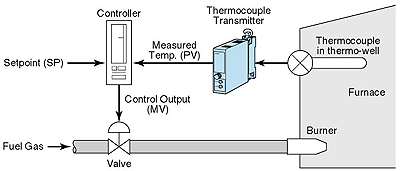We recommend using the thermocouple transmitter
with burn-out function. The effect of the burn-out function is as
follows:
The output of a thermocouple transmitter with the burn-out function
increases its output signal, if the thermocouple burns out. The controller
interprets the signal increase as if the furnace temperature became
higher. It changes the control output to close the control valve.
The burn-out function reduces fuel (gas) when the thermocouple burns
out.
Assume that the thermocouple burns out and the transmitter has no
burn-out function. Since the transmitter loses the input signal, its
output is suddenly reduced as if the furnace temperature is lowered.
In response, the controller changes its output to open the control
valve wider. Even though the furnace temperature becomes high, the
emf from the thermocouple remains zero, signaling to continue heating.
If the failure is undetected, the furnace overheats and may be damaged. |
 |
|
 What
is a process diagram of a typical temperature control system for a furnace?
What
is a process diagram of a typical temperature control system for a furnace?
 The
figure shows a simplified temperature control system of a gas-burning furnace
which uses a thermocouple for sensing the furnace temperature (The actual
system has more control elements).
The
figure shows a simplified temperature control system of a gas-burning furnace
which uses a thermocouple for sensing the furnace temperature (The actual
system has more control elements).